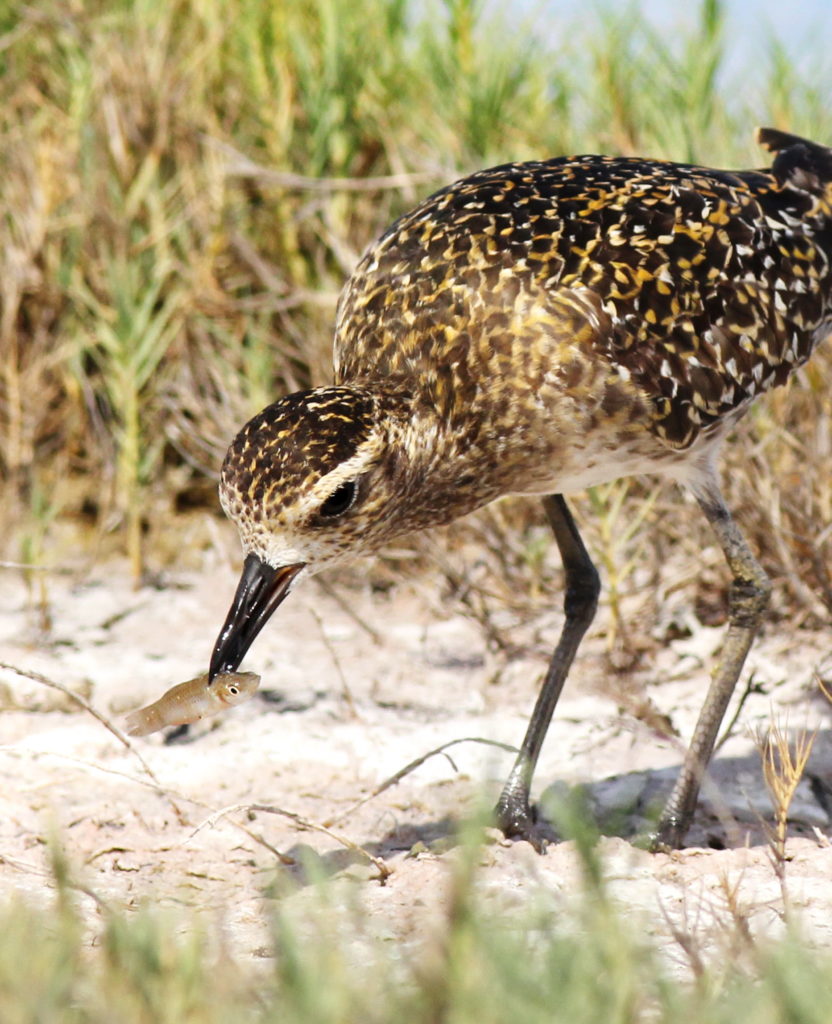Published in the Ocean Watch column, Honolulu Star-Advertiser © Susan Scott
April 22, 2017
We have four days left to admire our kolea friends, so stunning in their spring attire. On or near Tuesday most of the Pacific golden plovers we’ve been enjoying in our yards, parks, golf courses and cemeteries will leave for Alaska to raise their kids in the insect-rich Arctic. Underweight or injured birds will pass on nesting this year and stick around for the summer.
 A Pacific golden plover, or kolea, enjoys eating pieces of fish.
A Pacific golden plover, or kolea, enjoys eating pieces of fish.
Most of the birds will head to Alaska soon, except for the weak or sick.
Courtesy Robert Weber
How empty our yard will feel without Jude, the bird that has been brightening our days by dropping in for the occasional breakfast, lunch or dinner.
We live on a golf course, where Jude spends his time foraging. Most days, especially after rain, the pickings are so good in the grass that Jude prefers worms and bugs over eggs. During dry stretches, though, when he sees movement in our house, he flies to the lanai doors and waits patiently for some of the scrambled eggs we keep for him in the fridge.
I say patiently because before the egg toss I sprinkle some birdseed around the corner of the house to divert the mynahs’ and cardinals’ attention. Jude quickly learned that there’s nothing in that offering for him and stands rooted, waiting for me to dole out the yellow protein.
Jude, whom I called Julie before he showed his true colors, cannot swallow a piece of egg bigger than a pea. If I toss a chunk as large as, say, a lima bean, the bird drops it to peck it apart. The loose egg often gains the notice of our mynah-with-the-broken-leg who steals the egg from a surprised Jude’s beak.
This is why I was surprised when biologist-photographer friend Robert Weber emailed pictures of a kolea with a fish in its beak. Robert wrote, “I enjoyed watching (a kolea) fishing in shallow mud flats on Maui. It would wade around in the water, catch a fish, then carry it up the shore to tear it apart where it couldn’t get away. Interesting and entertaining.”
The fish is small, but still. It seems a kolea would quickly lose a fish to bandit birds before it could break it into beak-sized bits. But maybe our Jude is a first-year, inexperienced bird. Or he’s just slow.
I sent Robert’s photo to plover expert Wally Johnson, who emailed back, “We knew the little guys occasionally took fish, but had no images. Am very pleased to have these!”
We all are. Thanks, Robert.
The plovers’ signal to fly to Alaska is triggered by length of day. No one knows how the birds coordinate their actual departure. Over a few days they will gather in flocks, then suddenly fly to a great height and disappear.
A good place to see kolea assemble — and, with luck, witness the start of their incredible journey — is Kualoa Regional Park.
Fair winds, sweet birds. We await your return.